#Regenerative Biology
Note
I always wanted to ask, for the Fluffverse
what's the worst injury an axolotl (or any regenerative creature) can face and survive from it and recover?
Physically recover. Idk about the mental problems and PTSD to come after but yeah.
it kinda depends on the person tbh!
------
so for example, chiffon (who i belive has the most strongest regen ability in the fluffverse) can grow a whole limb in a few seconds
for him, as long as majority of his vital organs (heart/brain) are still intact, he can servive injuries that are mostly fatal to avrage person
this don't make him "ubkillable" though, even if he can manage a bullet through the head, he can still die if majority of his body get distroyed at once (ex: blown up, burned to death,ran over by a train, being crushed by a big rock ect ect)
meanwhile, muffin, who can still regenerate but in a MUCH slower pace (can grow 1 finger over a month span) , COULD grow a leg if it got cut off, but without quick medical treatment he'll probably die like a avrage person from bloodloss and shock
#ask#actually i think joie has the most strongest regen ability cause while axolotl bros are limited to biology he is kinda...more magic?#but joie is in the human verse so we gonna pass on that one
114 notes
·
View notes
Text
A small molecule previously shown to enhance strength in injured or old laboratory mice does so by restoring lost connections between nerves and muscle fibers, Stanford Medicine researchers have found.
The molecule blocks the activity of an aging-associated enzyme, or gerozyme, called 15-PGDH that naturally increases in muscles as they age. The study showed that levels of the gerozyme increase in muscles after nerve damage and that it is prevalent in muscle fibers of people with neuromuscular diseases.
The research is the first to show that damaged motor neurons — nerves connecting the spinal cord to muscles — can be induced to regenerate in response to a drug treatment and that lost strength and muscle mass can be at least partially regained. It suggests that, if similar results are seen in humans, the drug may one day be used to prevent muscle loss of muscle strength due to aging or disease or to hasten recovery from injury.
Continue Reading.
83 notes
·
View notes
Text
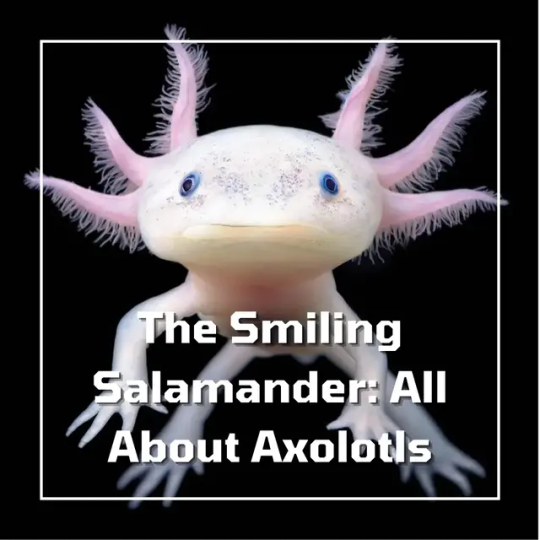

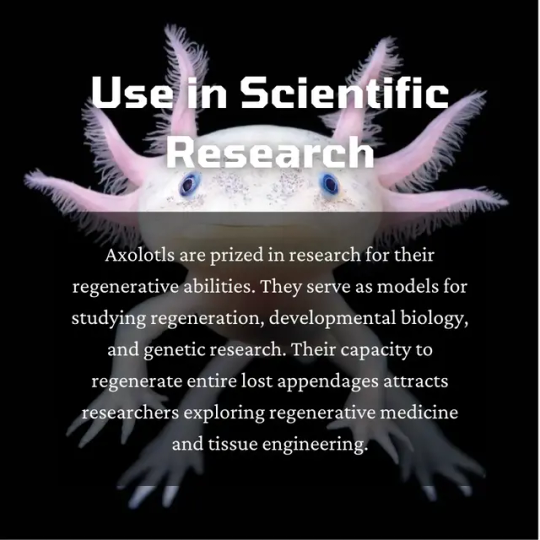
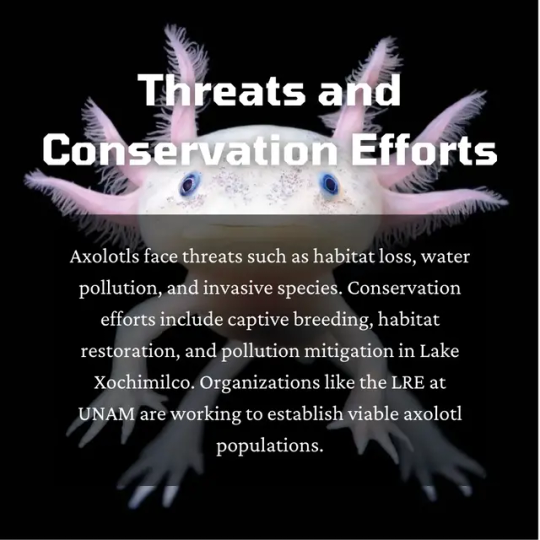
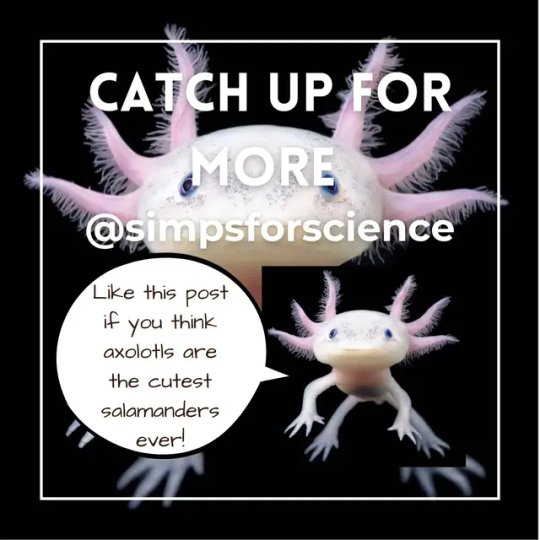
This little cutie is all smiles and secrets! Meet the axolotl, the forever-young amphibian with amazing regenerative powers. Read on to unlock their fascinating world! 🌟🐾🔬
#axolotl#regeneration#amphibian#regenerative medicine#endangered#endangered species#endangered animals#biology student#biology facts#sea creatures#biology#zoology#animal#animals#developmental biology#minecraft#science#science facts#education#discover#scicomm#study blog#biology studyblr#study blr#explore#nature#salamander#conservation#gills#simps for science
9 notes
·
View notes
Text
had a couple thoughts since i talked about regenerative immortality changing the cellular structure of the body, like the red blood cells turning to ichor where the job is to carry the godly energy in the cells alongside carrying oxygen throughout the body. perhaps the ichor transforms every cell into a stem cell which causes the regeneration (much like an axolotl or a hammerhead worm). stem cells have the capability to turn into any other kind of cell, so that would be how a deified mortal could regenerate a limb from bone cell all the way to skin cell. i have so many thoughts, speculative biology is soooooo much fun
13 notes
·
View notes
Text
i gave shan an obnoxious residency but i can't remember what
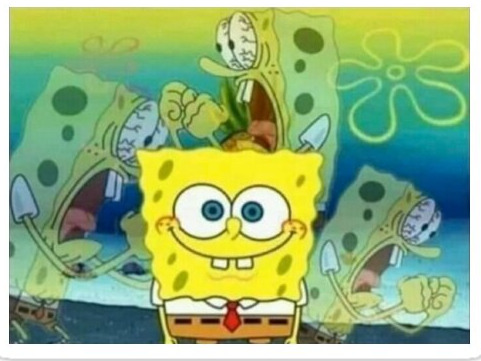
#it had to do with regenerative medicine but i am simply not in the same feral state of mind to dig through all that shit again#but LIKE her background isn't actually in hematopathology. it's cellular biology and she was well on her way to ..#well doing what she got bamboozled into doing anyway ( succeeding richard and continuing his vision for voss )
1 note
·
View note
Text
What are induced pluripotent stem cells, and how are they different from embryonic stem cells?
What are induced pluripotent stem cells (iPSCs)?
Reprogrammed adult cells: iPSCs are created in the lab by taking adult cells (often skin or blood cells) and genetically reprogramming them back to an immature, embryo-like state.
Pluripotency: Like embryonic stem cells, iPSCs are pluripotent. This means they have the exceptional potential to develop into almost any type of cell in the body.
Key…

View On WordPress
#biotechnology#Cell Therapy#Cellular Differentiation#Cellular Reprogramming#CRISPR#Developmental Biology#Embryonic Stem Cells#ESCs#Ethical Considerations#gene editing#Gene Expression#Immune Response#Induced Pluripotent Stem Cells#iPSCs#Medical Research#Pluripotency#Regenerative medicine#Stem Cell Research
0 notes
Text
Understanding Regenerative Medicine
By Arjuwan Lakkdawala
Ink in the Internet
It started in the 50s with the first bone marrow transplant, and stem cell research has taken off with promising results and astonishing insights into cells and genes, and the remarkable way in which human and animal bodies function on the cellular level.
Regenerative medicine is being tested and explored in the treatment of several diseases including cancer and heart disease, two of the leading causes of deaths world wide, researchers also have hopes of finding treatments through it and learning about how Alzheimer's diseases can be treated and its degenerative effects. This is of significance considering the rise of Alzheimer's disease in the past twenty years. (I suspect mobile phones maybe the culprit, read my previous article.)
So what are stem cells exactly and how are they being used in regenerative medicine?
There are many types of function specific cells in the body, the stem cells being tested and used are basically of two main types. One is the embryonic stem cells that are taken from an human embryo which is 3 to 5 days old and has 150 cells, and is from an egg fertilised in vitro fertilisation clinic and has not been implanted in the uterus. It is without a doubt controversial as it raises questions of the ethics of this particular research.
Stem cells can also be found in umbilical cord blood, and the amniotic fluid, which fills the sac surrounding the fetus in the womb.
Women giving birth in hospitals should be notified if the umbilical cord blood is taken for stem cell collection.
These stem cells have the capability to differentiate (turn into) almost any function specific cell in the human body, making them highly favourable for testing and studying how they mature, they can also be frozen to be stored without getting damaged, and they are stable and durable.
Stem cells with the capability to differentiate are called pluripotent cells.
The other type are adult stem cells that have already differentiated into function specific cells, these are found in the bone marrow and fat in the body. While at first it was thought that their capabilities were limited in treatment or testing, scientists are discovering that adult stem cells are useful in many ways and are easier to match to a patient than embryonic stem cells. Because the body's immune system is most likely to attack embryonic stem cells from a donor than its own adult stem cells that have been reprogrammed for treatment.
However, adult stem cells could have defects due to environmental hazards or toxicity.
In both main stem cell types it is tools of reprogramming that is being developed.
In 2006, the Nobel Prize-winning scientist Shinya Yamanaka and his team, at Kyoto University in Japan, discovered how to revert adult stem cells into embryonic stem cell like state.
This is called Induced Pluripotent Stem Cells or iPSC.
The genes that define an embryonic stem cell are there in every cell in the body but they are turned off. Yamanaka pioneered the technique to turn on those genes in adult stem cells. He did it by injecting molecules in the adult stem cells with the instructions to turn on the embryonic stem cell genes, and by this changing the identity of the adult function specific stem cell into an embryonic like stem cell.
The instructions for gene reprogramming are in proteins or chemicals that mimic proteins that have been selected to alter the identity of the stem cells into the function specific cells required for potential treatment or testing.
For example, if a patient suffering from heart disease is injected with healthy stem cells that have been turned into heart cells, they could help treat the heart.
Or in the case of testing, new drugs can be tested on stem cells that have been differentiated into the cell type in the body targeted by the drugs. Scientists can study if the drug is effective at treating the cells or causes adverse affects. This is of course much better than testing the drugs on living humans or even animals. Animals have suffered so much because of lab testing. I hope stem cells would be a sufficient alternative to animal testing.
The other way in which stem cell research is very useful is that through it researchers and scientists can study cells otherwise inaccessible. Like for example neurons in the brain.
Stem cells can be differented into neuron like cells, they won't be exactly the same but very close proxies.
Studying stem cells that have been successfully turned into different types of cells of the body in a culture petri dish allows scientists to much easily observe the onset of diseases and test possible treatments. Stem cells are also being considered as alternatives to organ transplant, and tests are ongoing in this context.
The human body has regenerative abilities like the skin healing after wounds or hair growing back. But it is the liver that is most astonishing as it has cells that can regenerate while other organs in the body don't. Scientist are studying why this is.
However, regeneration in humans is nothing compared to some species in the animal kingdom. Like for example worms, lizards, salamanders, jellyfish.
Researchers at Whitehead Institute are studying regeneration, and Professor Peter Reddien, is especially focused on a type of flat worm that has remarkable regeneration capabilities. The worm planarian can regrow its whole body even when it has been cut into pieces. Each piece will grow into a whole new worm.
Another worm was introduced for studying and testing by Professor Mansi Srivastav, the model worm suitable for testing and experiments is the three-banded panther worm. Both worm species have regenerative capabilities and studies have shown that neoblasts (worm stem cells) in the muscles of the worms are guided by Position Control Genes PCGs into regenerating the whole worm from each piece.
Scientists are developing new techniques of the process of actually introducing proteins or chemicals acting like proteins into the cell membrane of the stem cells or adult stem cells to be reprogrammed.
The percentage of successful reprogramming so far is not high. Previously a virus was used to inject transcription instruction factors into stem cells. But this method was imperfect.
Newer methods include using a plasmid, a circular DNA construct to enter the stem cell membrane with the transcription instructions, after the cell has been zapped with an electric current that makes a temporary hole in it.
While this method of using electricity to change genes is used in labs, a recent study from the University of Nagoya in Japan, studied electric eels that were used to zap zebra fish, using an electric field, they found that the genes of the fish had changed.
The study was published in the journal PeerJ-Life Environment.
"Electric eels and other organism that generate electricity. Could affect genetic modification in nature," said Atsuo Lida, professor and author on the study.
We don't know if the 860 volts discharged from eels in the amazon river has contributed to gene transfer between species but it's a possibility.
The human genome has ca. 20,000 genes that construct proteins. Genes and proteins are the building blocks of life.
Therefore stem cell reprogramming is wholly based on using proteins or chemicals mimicking proteins to alter cells into function specific cell types.
However, the creation of new genes is just as much a mystery as the start of biological life.
A recent discovery by the University of Helsinki in Finland, has a possible answer to the mystery of the mechanism behind the making of new genes. The classical genes that make proteins have regulatory genes, and as the university was studying errors in DNA replication they found that a mutation event can give rise to the very tiny sort of sub-genes from which perhaps other larger genes are made.
Arjuwan Lakkdawala is an author and independent science researcher.
X/Instagram: Spellrainia Email: [email protected]
Copyright ©️ Arjuwan Lakkdawala 2024
Sources:
SciTech Daily - Palindromic Puzzles Solved: the Hidden Mechanism of Gene Creation, University of Helsinki
National Library of Medicine - Induced Pluripotent Stem Cells: Reprogramming Platforms and Applications in Cell Replacement Therapy, Akram Al Abbar, Stewart Ching Ngai, Nadine Nograles, Suleiman Yusuf Alhaji, Syahril Abdullah
Electric Eel Zaps can Change Fish DNA - Popular Mechanics, Tim NewComb
ISCRM - What is Cell Reprogramming
The Science of Self-Repair: Regeneration Research at Whitehead Institute by Greta Friar
Mayo Clinic Staff - Stem Cells: What are they and what do they do

#Arjuwan Lakkdawala#regenerative medicine#stem cells#cell reprogramming#gene editing#ink in the Internet#science#electric eels#adult stem cells#biology#nature
0 notes
Text
Regenerative Potential of ADSCs

ADSCs have shown immense potential in tissue engineering due to their remarkable regenerative capabilities. They possess the ability to differentiate into multiple cell lineages, including adipocytes, osteoblasts, chondrocytes, and myocytes. This multilineage differentiation potential makes them suitable for regenerating various types of tissues and organs.
Read more:- https://kosheeka.com/unveiling-the-potential-of-adipose-derived-stem-cells-in-tissue-engineering/
#research#kosheeka#cellculture#cell culture#biotech#primarycells#biotechnology#cell biology#primary cells#cellbiology#Adipose tissue#stromal vascular fraction#SVF#endothelial cells#fibroblasts#isolation of ADSCs#Regenerative Potential of ADSCs
1 note
·
View note
Text
Do we exaggerate the dangers of conventional fabrics?
We received a comment on one of our blog posts recently in which the reader chastised us for exaggerating issues which they believe are disproportionate to the facts. In their words: For instance formaldehyde… is a volatile chemical…no doubt it is used in the textile industry a great deal…but looking for this chemical in end products is an example chasing a ghost…. It has to be put in…
View On WordPress
#25th National Pesticide Forum#American Federation of Government Employees#Bangladesh#body burden#chemical-laden#Chemicals#Dr. Laura Vandenberg#Dr. Warren Porter#Dzershinsk#epigenetics#fabric#formaldehyde#Greenpeace#Hazaribagh#healthy#industrial chemicals#Minamata#Russia#Toxic Textiles by Disney#Tufts University Center for Regenerative and Developmental Biology#Victoria&039;s Secret#Washington State University
0 notes
Text
"A team at Northwestern University has come up with the term “dancing molecules” to describe an invention of synthetic nanofibers which they say have the potential to quicken the regeneration of cartilage damage beyond what our body is capable of.
The moniker was coined back in November 2021, when the same team introduced an injection of these molecules to repair tissues and reverse paralysis after severe spinal cord injuries in mice.
Now they’ve applied the same therapeutic strategy to damaged human cartilage cells. In a new study, published in the Journal of the American Chemical Society, the treatment activated the gene expression necessary to regenerate cartilage within just four hours.
And, after only three days, the human cells produced protein components needed for cartilage regeneration, something humans can’t do in adulthood.
The conceptual mechanisms of the dancing molecules work through cellular receptors located on the exterior of the cell membrane. These receptors are the gateways for thousands of compounds that run a myriad of processes in biology, but they exist in dense crowds constantly moving about on the cell membrane.
The dancing molecules quickly form synthetic nanofibers that move according to their chemical structure. They mimic the extracellular matrix of the surrounding tissue, and by ‘dancing’ these fibers can keep up with the movement of the cell receptors. By adding biological signaling receptors, the whole assemblage can functionally move and communicate with cells like natural biology.
“Cellular receptors constantly move around,” said Northwestern Professor of Materials Sciences Samuel Stupp, who led the study. “By making our molecules move, ‘dance’ or even leap temporarily out of these structures, known as supramolecular polymers, they are able to connect more effectively with receptors.”
The target of their work is the nearly 530 million people around the globe living with osteoarthritis, a degenerative disease in which tissues in joints break down over time, resulting in one of the most common forms of morbidity and disability.
“Current treatments aim to slow disease progression or postpone inevitable joint replacement,” Stupp said. “There are no regenerative options because humans do not have an inherent capacity to regenerate cartilage in adulthood.”
In the new study, Stupp and his team looked to the receptors for a specific protein critical for cartilage formation and maintenance. To target this receptor, the team developed a new circular peptide that mimics the bioactive signal of the protein, which is called transforming growth factor beta-1 (TGFb-1).
Northwestern U. Press then reported that the researchers incorporated this peptide into two different molecules that interact to form supramolecular polymers in water, each with the same ability to mimic TGFb-1...
“With the success of the study in human cartilage cells, we predict that cartilage regeneration will be greatly enhanced when used in highly translational pre-clinical models,” Stupp said. “It should develop into a novel bioactive material for regeneration of cartilage tissue in joints.”
“We are beginning to see the tremendous breadth of conditions that this fundamental discovery on ‘dancing molecules’ could apply to,” Stupp said. “Controlling supramolecular motion through chemical design appears to be a powerful tool to increase efficacy for a range of regenerative therapies.”"
-via Good News Network, August 5, 2024
#nanotechnology#osteoarthritis#arthritis#medical news#science news#cell biology#molecular biology#cartilage#good news#hope
704 notes
·
View notes
Text
Elrond With A Modern Medical!Reader in Valinor

Request: Not sure if this is fic or just headcanons but: Modern!reader in middle earth who was a neurosurgeon in her old life and is now in Valinor working with Elrond to translate medical concepts to elven language before she dies and help advance their medical practice. Some differences between elven and human biology are found out in the process, it’s all quite fascinating to them both. She assists in a few operations but I imagine they don’t have many surgical operations to do in times of peace because people just aren’t getting injured like they used to during the famed battles against Morgoth and Sauron in middle earth. She helps on occasion but them elves are graceful and not injury-prone. - Anon
A/N: I was having trouble turning this into a fic, and since you gave me the option, not minding if I did a headcanon, I went with the latter. I had fun writing this, I also made their relationship ambiguous. Enjoy!

When you happen to arrive in Valinor, dazed by its eternal beauty and tranquillity, Elrond, with all his calming presence and wise demeanour was the first to greet and help you settle down. He was kind to welcome you into his new home.
During your time there, you and Elrond spend countless hours in his extensive library, trying to translate complex medical texts and concepts into Quenya, while he marvels at the intricacies of human detail in neurosurgery. To him, the ability to heal the brain by getting so practical and up close was fascinating.
“You humans certainly love your precision and details,” he would say as he smiled while reading through a description of a delicate brain surgery. You on the other hand would laugh and tell him that not all humans are so meticulous, following up your comment by sharing more medical mishaps from your world.
It is when you discover the biological differences between elves and humans, that things in the work become all the more interesting. You discover that elves’ regenerative abilities allow for healing preparations to be cut down and rushed to the healing wing, unimportant. Just knowing this, leaves you speechless as he casually mentions recovering from an injury that would have left a human incapacitated.
“So you’re telling me that you can heal from a stab wound in a matter of days?” you ask, incredulously with jealousy lingering. Elrond would simply nod along with a serene smile as he continued to translate the prewritten text on the paper you provided. “I wish I had that. Would have saved me all those trips to the ER.”
Assisting in medical practices in Valinor is rare but rewarding. Elrond’s precise, yet holistic approach to medicine complements your surgical expertise perfectly. Together, you manage to save a few elves who came in with nasty injuries, mostly from hunting trips gone bad.
As time passes, you are further blown away when Elrond teaches you their famous art of healing through song and rare herbs, enchanting your understanding of medicine. You do find the elves’ ability to enter healing trances particularly fascinating.
“So you just…sing them better? Like kumbaya and poof! Healed?!” you asked one day as you attempted to wrap your head around the concept, prompting Elrond to chuckle. “In a manner of speaking, yes.”
As time passes, your collaboration deepens both your understanding and respect for each other’s knowledge and expertise. Elrond is continually impressed but your surgical and modern techniques, while you are captivated by the elves’ natural form of advanced healing practices. This welcomed late nights in the library often turning into philosophical discussions as Elrond is thrilled by your stories of modern technology, and you are equally captivated by his tales of Middle-Earth.
You even meet a few of his family members during your stay as words of another human dwelling in Valinor. “Wait, you all fought a literal Balrog? Those fiery beasts?” you asked one evening as you sat around a table chatting with those who encountered the creature. “If you all were in my world, you could have used a fire extinguisher to put the flames out, or just douse water on them.” You leave most of them in laughter and confusion.
Due to meeting other elves beside him, you get the opportunity to practice your healing methods on them, though, they rarely allow you to since they usually appear fine even when injured. “So you couldn’t have hit your head a little harder for me to have something to examine instead of magically healing?” you disappointedly asked one of Elrond’s family members.
That has been the relationship for most of the encounters when an elf decides to come in sporting an ‘injury’. “You said you cracked your skull four days ago while hunting but I’m not seeing any injury. Do you mind if I hit you so I can have an actual injury to work with?”
Like you, even Elrond has his moments of being light-hearted, despite his dry sense of humour, when things don’t go according to plan. If the technique is too complex, he’ll jokingly say, “Of course, if all else fails, we just use magic.” Of course, you blink at him wondering if he was being serious or joking.
The partnership between you and Elrond as your work in Valinor developed certain areas of elven magical was tedious but also worthwhile. Even the relationship between you brought each other comfort and upliftment. “I suppose I’ll be remembered as the strange human who brought surgical scalpels to the Blessed Realm and threatened to beat people in their heads,” you joked.
Elrond usual response is filled with a sense of gratitude as he makes a toast in your honour. “You will be remembered as a pioneer and someone we are grateful to have encountered. I am glad you were brought here,” he fondly cheered.
Even as your time in Valinor progresses, you and Elrond continue to explore new ways to incorporate your medical practices into their elven healing. Each time an elf stops by for healing, you sometimes have to threaten them to come in with noticeable head injuries or you’d give them, while other times, you are lucky to have something to deal with. At least, during your years there, you managed to get a lot done.

Masterlist
Taglist: @lilmelily @ranhanabi777 @rain-on-my-umbrella @mysticmoomin @asianbutnotjapanese @batsyforyou @aconstructofamind @mcwentfandomtraveling @involuntaryspasms @stormchaser819 @addaigio @lamemaster @elficially-done-with-life
#elrond x modern!reader#elrond headcanon#elrond imagine#elrond scenario#elrond x reader#elrond#lord of the rings imagine#lord of the rings headcanons#lord of the rings x reader#silmarillion x reader#silmarillion imagine#silmarillion headcanons#middle earth x reader#middle earth imagine#middle earth headcanon#modern reader in middle earth#lotr x reader#lotr imagines#lotr headcanons#x reader insert#x reader fluff#house of elrond#silmarillion#lord of the rings#doodlepops writings ✨
240 notes
·
View notes
Note
don’t wanna get too into it bc… nsfw but how does asexual greed work when he literally says that he wants sex and women? is he just not attracted to them in that way or–
well in terms of nitty-gritty homunculi biology they are quite literally an asexual species, like father reproduces via budding lol. And then given his physical embodiment of lust herself seemingly has no sex drive and is instead Way more interested in killing it's a pretty easy conclusion that as a species they just have no sexual interests because why would they (pretty sure father as the dwarf in the flask had some comments about finding human pairings distasteful, and given all his kids are just offshoots of his personality i can't see that shifting much haha (also more shitposty take but there's the much funnier observation that all of the homunculi come with their funny little onsies literally built-in to their regenerative code so there is an incredibly real chance they're all just ken dolls down there anyways))
as for why greed himself says stuff like wanting women and sex etc., i mean he also says he wants money and power and the finer things in life and then spends his time happily hanging out in a dingy dive bar with no real long-term goals besides 'hang out with my friends and investigate immortality which is definitely for me and not for anyone else that i'd be sad to see die no siree don't ask me why i'm doing this if i'm already virtually immortal'
so yeah it's a fun aspect of his character that greed says he tells the truth but he will also just sort of...lie about his own drives to himself and others all the time lol - i'd almost chalk it up to his love of performance but there's def also some intentional personal misdirection going on, which was very obvious as greedling when ling (correctly) calls him out on acting like all he wants is power when really the only thing he wants is to have friends
basically he says he wants money and power and women and sex because that's what common human desires are but then he makes absolutely 0 effort to follow through on any of those claims because deep down that isn't actually anything he's interested in

#greed: haha yeah I want money and sex and the finer things#also greed: what if I lived in a sewer#anyways i'm sure i've made these arguments more eloquently before but I can't be bothered to find those asks again right now haha#but yeah greed is a funny guy who is also a Fascinating character study when you remember he represents a driving part of what was the dwar#a lot of bravado hiding a genuine desire for human connection#reply#fma#meta#i suppose lol
189 notes
·
View notes
Text
I want to give a shout out to the resource of melanin. Not enough conversation and studies are being done on the vital power of melanin, a power that has been mostly suppressed and hidden by dominant culture. It is part of my responsibility to make sure that I live in this highly-melanated body to the fullest, to not take any drop of melanin for granted, to spend as much time as I can in the warmest sun, and begin to speak more on the beauty and wisdom of melanin. Melanin literally absorbs sunlight, a cosmic frequency, as oppose to reject it and become inflamed and infected as a result. Pause. This is huge because it means that the more melanin your body holds, the more light your body carries, and the stronger and more regenerative it is. When harnessed appropriately through opening your heart and limiting how much sugar, seed oils, and processed an packaged foods you ingest and become fueled by, you naturally have more awareness and sight, a higher overview of consciousness. And none of this is about "race." It is about light. It is about divine energy. It is about biology. It is what is real and true yet suppressed and hidden. -India Ame'ye, Author
84 notes
·
View notes
Text
The State of Shimmer Production in Zaun
When Jayce and Vi raided Silco's Shimmer Refinery they really showed that they didn't know how to actually handle Shimer. I'm not talking on a socioeconomic level, or even Hextech vs Shimmer (chemtech), I mean they don't know where it comes from. The way Vi tears apart the central machinery of the refinery show its.
At first it looks like she did a good job just breaking every glass and pipe on their, but if you look closer, she missed something critical.

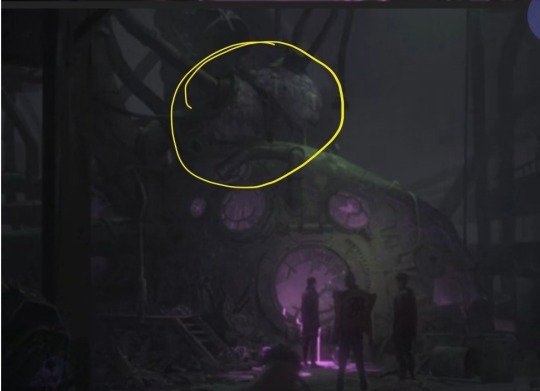
1It's the giant mass that's holstered right above. This mass of flesh is the actual source for Shimmer that the Refinery had been using. Sure it looks like a sagging lump of dead flesh, but that actually seems to be it's normal color.
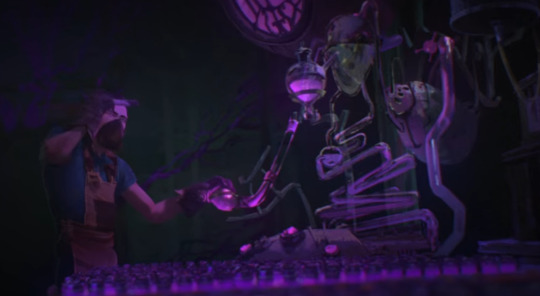
We've seen a mass like this before, in the Cannery. While Vander was captured, we're shown Shimmer being produced by one of Silco's chemists.

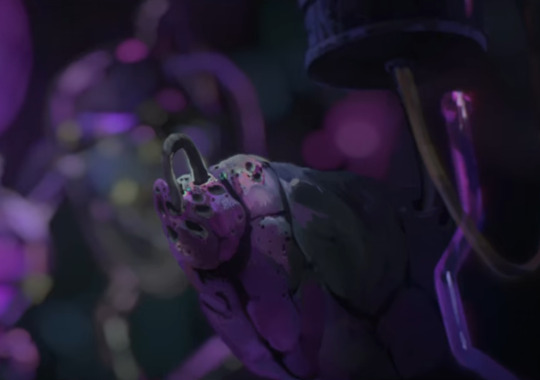
Up close, you can see the same grey flesh masses found in the refinery, sitting in their own liquid, are being used at a smaller scale in the Cannery. The larger mass was literally pumping on its own, though I'm not sure if it's with the aid of heat or gas. Nevertheless, we can see that these are the actual sources that Shimmer is harvested from, and Vi missed it. Well, more like the whole team missed it. They just left it there instead of confiscating it.
But where did these masses even come from? The answer itself is easy, it's Rio. The explanation is a little complicated.

We already know that long term exposure to Shimmer causes Shimmer addicts to develop growths, like the ones Huck has. These growths pulse with bright pink veins, likely producing some poorer quality strain of Shimmer to sustain the growth itself, but this process is somehow isolated to the growth and not the rest of Huck's internal biology. If anything it looks as though the mass is feeding off of Huck.
The only living organism that could possibly produce masses of the size used in the Shimmer Refinery that produce Shimmer in a consistent quality is Rio.

Initially, I assumed that Singed kept Rio alive because Rio was the source of Shimmer, but I had it backwards. Singed didn't keep Rio alive because Rio made Shimmer, he kept Rio alive because of how Rio could 'survive' Shimmer.

Rio is literally a giant aoxotl, a species best known for it's regenerative abilities, where they can lose limbs and regrow them like it's nothing in the right conditions. Singed kept Rio alive (aoxotls only live 15 years in captivity) using Shimmer harvested from it's original source, the purple cave flowers, because with Rio, Singed has a reliable biological medium that he can harvest these Shimmer producing masses from.
You could even argue that with the hinted at parasitic nature of Shimmer, new strains of Shimmer, like the ones produced by Rio, are impacted by the biological traits of the host body. This could explain how Shimmer is such an effective treatment for fatal conditions.
But what does this all mean? Well, for one, it proves Vi and Jayce really went into the raid more blind than we already thought. They were able to identify the mechanical heart, which can be fixed or replaced, but not the more critical biological source, and thus failed to truly immobilize production. Even worse for them, both still don't know anything about Rio, the only one in Piltover who does know is Viktor.

Even if Vi could guess that those Shimmer masses were important, I doubt she could have done anything effective. From what we could see in the first season, these masses don't require any medical appartus to keep functioning, they already appear self-sustaining outside a host. Any equipment around them seem to function to stimulate excess Shimmer production.


And if we return to the Cannery, we can see that the Shimmer veins, these sinew-like byproducts of Shimmer production are still hearty and alive. After the explosion and massive fire that engulfed the Canney over 7-10 years ago in the story, the Shimmer veins not only remained, but have expanded through rock, ruble and the chemical pollutants in Zaun, thick and alive. What would stabbing or smashing it actually do?


In some shots they really look as though they're surrounding the cast, especially Jinx. Whatever surgery that was done to Rio, she was probably given a more 'refined' version. The kind where the Shimmer and whatever guides it's nature better integrated into her system compared to long term users that are being drained by it.
Part of me wonders that as another 'successful' mutant like Rio, can she produce excess Shimmer in the right conditions. Could she draw it from herself in secret to give to allies, or withold it Queen of the Damned style. I wonder what traits her strain of Shimmer might give to users.
Tldr: When Jayce and Vi raided the Shimmer Refinery, they missed a biological factor that's the center of Shimmer production. As long as Singed still has the cave flowers and Rio, Zaun still has Shimmer. Also, all Shimmer users that have been exposed to large enough quantity can to some degree produce Shimmer, but it's not always a well integrated process, so Jinx is likely a real success in Shimmer hybridization.
#arcane#singed arcane#vi arcane#jayce talis#zaun#shimmer arcane#jinx arcane#I'm not a biologist#arcane meta#i had more vampire analogies but i couldn’t digressing#rio arcane
163 notes
·
View notes
Text
Weird hypothesis on Hellsing Vamps and maybe just vamps in general focusing mainly on Alucard. I know Hellsing vampires are rather eldritchian in how their biology works, this being most true of Alucard, however I want to focus on their teeth.
Alucard has lived for centuries, and I know he can shape-shift and I know his teeth seems to shift based on his emotions and whatever the hell he's doing at the time, this sort of suggests Alucard doesn't generally have control over how his teeth appears for the most part. Like he does, but if he's pissed off enough, his teeth will appear far sharper and more monsterous as a result of that anger.
Having said that, I always think about how Alucard's teeth are generally speaking quite sharp, including his fangs. Teeth do wear down with time, and while yes it's entirely possible Alucard's shape-shifting negates the wear and tear expected after centuries of life; I give the hypothesis that the shape-shifting doesn't actually negate the damage done over time, and Alucard, much like a shark, periodically shed his teeth. This most often probably happens to his canines, and likely doesn't happen all at once. Most likely what happens is he will find a loose tooth, pull it out in which case due to his rather fast regenerative abilities, a new tooth almost immediately takes its place.
Now this is all speculative, but it does make sense to me that when Alucard's teeth start to become dull, they will straight up fall out and be replaced by new ones. Like I imagine sometimes what will happen that he will bite something (or someone), and he will just find a tooth having fallen out. I imagine this was probably kind of disturbing the first time it happened but he's grown used to it, and that some teeth fall out more regularly than others.
It's an interesting concept, because my other theory would be that his teeth are essentially always growing and he does geniunely need to find ways to wear them down lest his fangs get too long. Either theory is fascinating in my eyes.
#vladcard#enjoy my rambles#hellsing#alucard hellsing#alucard#vampire biology#alucard headcanons#hellsing headcanons#Alucard's biology is very fascinating to me and I do want to do more with it#i just have no idea where to fucking start#so have this hypothesis on Alucard's dental plan
166 notes
·
View notes
Text
What is Biotech? Unlocking the Power of Biology
“Unlocking the Power of Biology: Biotech Innovations Transforming Our World”
Biotechnology: Revolutionizing Industries and Improving Lives
Biotech, short for biotechnology, is a rapidly evolving field that combines biology, genetics, and engineering to develop innovative solutions for various industries and aspects of our lives. From healthcare and agriculture to environment and energy, biotech…
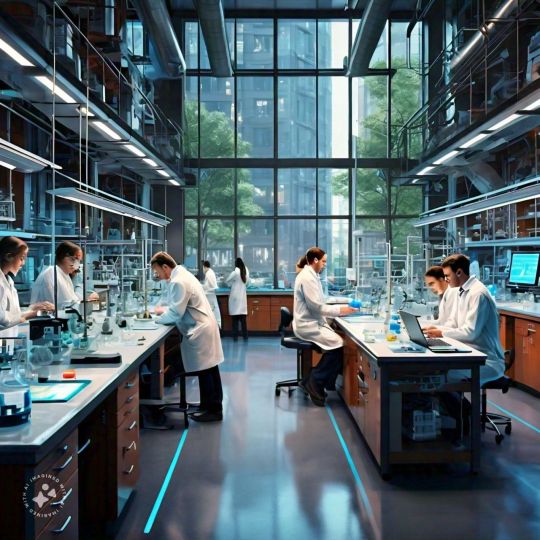
View On WordPress
#Innovation#agriculture#biofuels#bioinformatics#biology#biomanufacturing#biomaterials#bioprocessing#biosensors#Biotech#biotechnology#gene editing#gene therapy#genetic engineering#genetics#genomics#healthcare#personalized medicine#recombinant DNA technology#regenerative medicine.#science#sustainability#synthetic biology#technology
0 notes